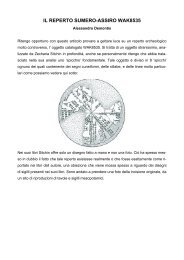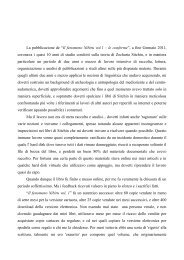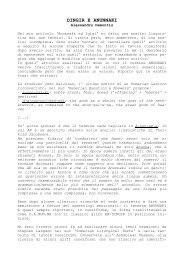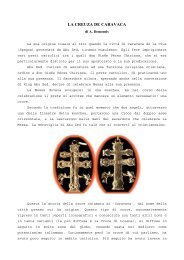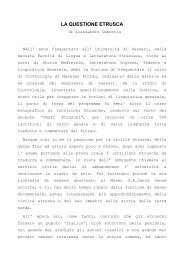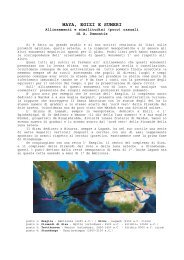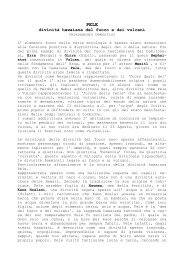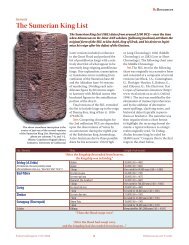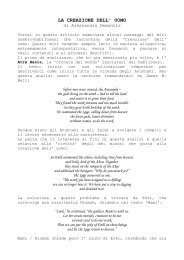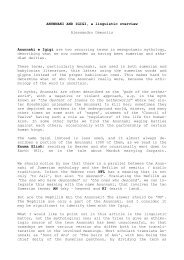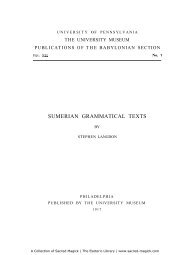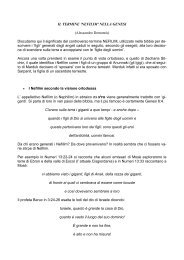Elementary Sumerian Glossary
Elementary Sumerian Glossary
Elementary Sumerian Glossary
Create successful ePaper yourself
Turn your PDF publications into a flip-book with our unique Google optimized e-Paper software.
uru (ki) , úru city, town; (referring to a specific city?)<br />
Most now read iri with Edzard, AV Civil 77-79, but<br />
see Lambert's strenuous rebuttal, AuOr 10, 256-258.<br />
Attinger, ZA 88, 167 n. 11, states that the OB writing<br />
úru is "in origin certainly the Emesal form of iri"; see<br />
also NABU 2008 p. 104.<br />
uru-bar(-ra) outskirts, suburbs<br />
uru4 to plow, till<br />
uru16(n)(EN), uru17(ULU3), u18(ULU3)-ru high, lofty,<br />
giant; powerful, mighty, strong (Ludwig, Išme-Dagan<br />
107-113; Alster, AV Klein 10f.)<br />
urudu, uruda (also a-ru12(EN)-da in Presargonic<br />
Lagaš) copper (Reiter, AOAT 249, 149ff.) (Perhaps <<br />
IE *roudhous, Foster, Umma in the Sargonic Period<br />
33; but see also suggestion of Yuhong, AV Klein<br />
388f.)<br />
urugal (or irigal) netherworld; grave (poetic)<br />
us-ga (a kind of priest?); treasury(?) (conventionally<br />
translated as "fattening pen") (see Michalowski,<br />
Lamentation p. 104f.)<br />
ús to be adjacent to, border on, come or bring up next<br />
to (-e); to lie or lean against, upon ; to follow, go<br />
immediately behind, chase<br />
kuš usàn, ù-sa-an whip (for construction and parts see<br />
Civil, Farmer's Instructions p. 72)<br />
ús (uš?) length, long side (in measurments)<br />
usar, ušar, ùsar, ùšur friend, neighbor; cf. ùsar dagi4-a<br />
"neighbor" (Steinkeller, Sales Docu-ments 242f.)<br />
ussu eight (Edzard, AV Klein 103)<br />
usu, ù-su physical strength, power; labor-force<br />
uš building lot, foundation (platform)<br />
uš-bar weaver<br />
úš death; (blood(?) perhaps read uri4 and connect with<br />
ùri?)<br />
úš(TIL), ug7(TIL), ug5(BÀD) to die In OS úš is used<br />
for imperf. sg., ug5/ug7 elsewhere. In Ur III Drehem,<br />
ug7 is used for a group of dead animals of the same<br />
kind, ug7-ug7 for a variety of dead animals<br />
(Sallaberger, AfO 40/41, 53; Heimpel, JAOS 119, 523<br />
contra Steinkeller, ZA 71, 25). The úš vs. ug7<br />
distinction may not have been maintained much<br />
beyond the Ur III period.<br />
uš11(KAxÚŠ) deadly spittle, venom, poison (cf. uh<br />
and note that uš11 also has the value uh4)<br />
ušbar mother-in-law<br />
úšu thirty (Edzard, AV Klein 105)<br />
ušum serpent<br />
ušumgal(GAL+UŠUM), ušum-gal great serpent,<br />
"dragon" (poetic)<br />
utu sun(light); the sun god Utu, city-god of Larsa<br />
(d) utu-è sunrise, east (some read u4-è when<br />
determinative is lacking)<br />
utu- šú → u4-šú<br />
útug, údug mace (reading šíta is obsolete)<br />
útul tureen (written with the same sign as tu7 soup)<br />
uz mušen (wild) duck (Veldhuis, Education 303) (the<br />
determinative is often omitted to avoid a double HU<br />
sign)<br />
ÙZ → uzud<br />
uzu flesh, meat; determinative for body parts and meat<br />
cuts<br />
uzu-a-bala meat broth (ummar mê šīri) (Steinkeller,<br />
BSA 8, 49 + n. 5)<br />
uzud(ÙZ) (female) goat Some maintain the old<br />
reading ùz; others hypothesize a form ud5. Steinkeller,<br />
Third-Millennium Texts 47, assumes uzud loses the<br />
second /u/ when another vowel follows, becoming<br />
/uzd/.<br />
uzud-saĝ bellwether; foremost one, leader<br />
uzug5, usug5 sexually unclean (syllabic writings exist,<br />
especially in Gudea texts, e.g. ú-sig)<br />
61



